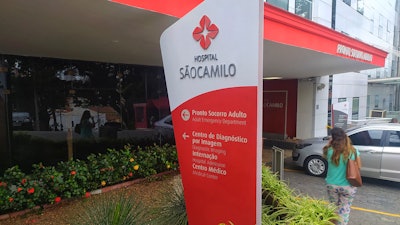
A recent study found that 31.4% of trauma patients tested at Latin America’s largest hospital complex had consumed psychoactive substances. Alcohol was used by 23%, cocaine by 12%, and marijuana by 5%. Traces of more than one drug were detected in 9% of the blood samples.
The patients were being treated at Hospital das Clínicas, located in São Paulo, Brazil. The complex is run by the University of São Paulo’s Medical School (FM-USP).
The findings come from a study by FM-USP in collaboration with the Oslo University Hospital in Norway. An article reporting them is published in the journal Injury.
“There was a lack of data in Brazil on alcohol and illicit drug use by patients hospitalized for treatment of severe injuries due to traffic accidents, violence or falls,” said Henrique Bombana, first author of the article and a researcher at FM-USP’s Center for Forensic Sciences. “In this study, accurate tests showed a high prevalence of psychoactive substance use. The findings can contribute to the formulation of more assertive public policies and prevention of accidents.” The project received funding from FAPESP.
According to Bombana, the absence of science-based public policies is one of the main hindrances to the control of drug abuse. Consumption of psychoactive substances is a risk factor for avoidable accidents, and proper management would help reduce the burden on Brazil’s national health system, known as the SUS (Sistema Único de Saúde).
Cross-sectional study
Between July 2018 and June 2019, patients aged more than 18 with traumatic injuries sustained in traffic accidents, falls and episodes of violence such as aggression, shooting, and stabbing were recruited at Hospital das Clínicas. Only subjects hospitalized for more than 24 hours were included in the analysis. “We wanted to assess the prevalence of psychoactive substance use in the most critical cases,” Bombana explained. The study involved a total of 376 participants with an average age of 36. Males accounted for 80%.
After the patients were stabilized in the emergency room, blood samples were taken. To be included in the study, they had to be collected no more than six hours after the injury was sustained. “Otherwise, the level of alcohol or drugs stops reflecting the level prevailing at the time of the injury owing to metabolization,” Bombana said.
The blood samples were sent to Oslo University Hospital, where they were analyzed using ultra-performance liquid chromatography (UPLC) and mass spectrometry (MS). According to Bombana, UPLC separates different substances present in the blood, while MS identifies them.
The volunteers provided socio-economic information and answered a questionnaire about gender, age, marital status, and education. They also completed the Alcohol Use Disorder Identification Test – Concise (AUDIT-C), a form with three questions designed to find out if the subjects habitually consumed harmful amounts of alcoholic beverages.
The results showed that 44% did so, while also pointing to a correlation between the use of cocaine and positive AUDIT-C test results.Injuries were divided into three categories based on their causes – traffic accidents, violence, and falls – as well as the day and time of their occurrence. The researchers found that psychoactive substances were consumed most by men (35%), individuals aged 18-39 (41%), unmarried volunteers (43%), and subjects who sustained injuries at night (44%). “These are groups that tend to consume more drugs and expose themselves more to risky situations,” Bombana said. As noted earlier, the overall prevalence of alcohol and drug abuse in the study was 31.4%.
Traffic accidents
Traffic accidents caused injuries to 56% of the patients analyzed. Roughly half of these cases involved motorcyclists. In the article, the authors stress that motorcyclists account for a much higher proportion of road traffic in developing than developed countries, and more frequently sustain severe injuries than car drivers because they are less protected.
In the study, 31% of the patients who had been involved in road accidents tested positive for illegal drug use. According to Bombana, previous research suggested that levels were lower among motorists not involved in accidents. For example, a study in which he also took part analyzed data for 10,294 drivers stopped at checkpoints in São Paulo City in 2016. Breathalyzer testing showed 4.1% above the permitted blood alcohol concentration. Another study in which Bombana was also involved showed a 7.8% prevalence of illicit drug use by truck drivers in São Paulo State.
“Direct comparisons aren’t possible because the studies used different methods, but it can be hypothesized that the consumption of psychoactive substances both favors accidents and makes severe injury more likely,” Bombana said.
The data reinforces the need to educate the public about the effects of these substances on accident rates while also actively surveilling driver alcohol and drug intake. “A point worth discussing is whether roadside tests for illicit drug use should be more frequent and widespread,” he added.
Most checkpoints in Brazil look for evidence of drunk driving. According to the study, 21% of the volunteers hospitalized for traffic injuries tested positive for alcohol, followed by 11% for cocaine and 6% for marijuana.
The use of alcohol and other drugs contributed to some 200,000 deaths in traffic accidents in 2013, according to the World Health Organization (WHO). In a 2017 study of ten Latin American countries, one in six people injured in traffic accidents had consumed alcoholic beverages.
Violence and falls
In the FM-USP study by Bombana et al., 13% of the 376 volunteers were hospitalized for treatment of injuries due to violent acts. Half of the injuries were caused by firearms and a quarter by physical aggression, while a fifth were penetrating traumas such as stabbings. This subgroup had the highest prevalence of alcohol and drug use (44%) and the lowest average age (31). In the case of aggression, 75% of the samples tested positive for alcohol and drugs.
“These findings cause concern, but they point to the high potential for a public policy aiming at control of alcohol and drugs,” Bombana said.
Hospitalizations for treatment of injuries due to falls accounted for 32% of the patients in the study. Of these, 29% had consumed alcohol or drugs; this was the lowest prevalence for the three categories. On the other hand, they had the highest average age (42).
Cocaine versus marijuana
Although marijuana is the illicit drug most consumed in Brazil, the prevalence of cocaine use was higher among the patients included in the study. In the article, the authors suggest cocaine use may lead to more violent behavior than marijuana, possibly resulting in intentional injuries.
Furthermore, combined use of alcohol and cocaine was the most frequent in the study. Cocaine is used to reduce the depressive effect of alcohol, and alcohol can also be used to intensify the euphoria fueled by cocaine or to mitigate its negative effects, the authors explain.
Limitations and next steps
Bombana explained that it was not possible to estimate the use of psychoactive medications by the volunteers, although this could also have contributed to the accidents. Another limitation was the exclusion of patients who died from their injuries. In addition, the study was conducted at only one hospital in São Paulo and care should be taken to avoid extrapolation. “Nevertheless, it’s important to note that we recruited a large number of participants at a major hospital in this very large metropolitan area, so the sample was significant,” he said.
Besides the Center for Forensic studies, researchers from several other areas of FM-USP took part in the study, such as the Departments of Preventive Medicine and Surgery, and the Institute of Orthopedics and Trauma. Part of the team is now studying the rehabilitation of patients after injuries in accidents to see whether their recovery is impaired by alcohol and drug use, among other aims.






















